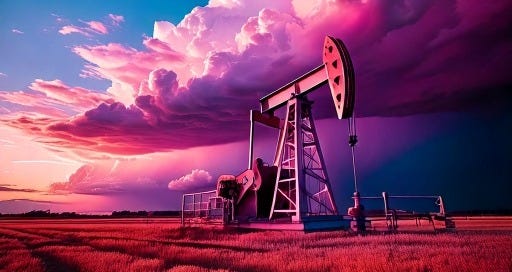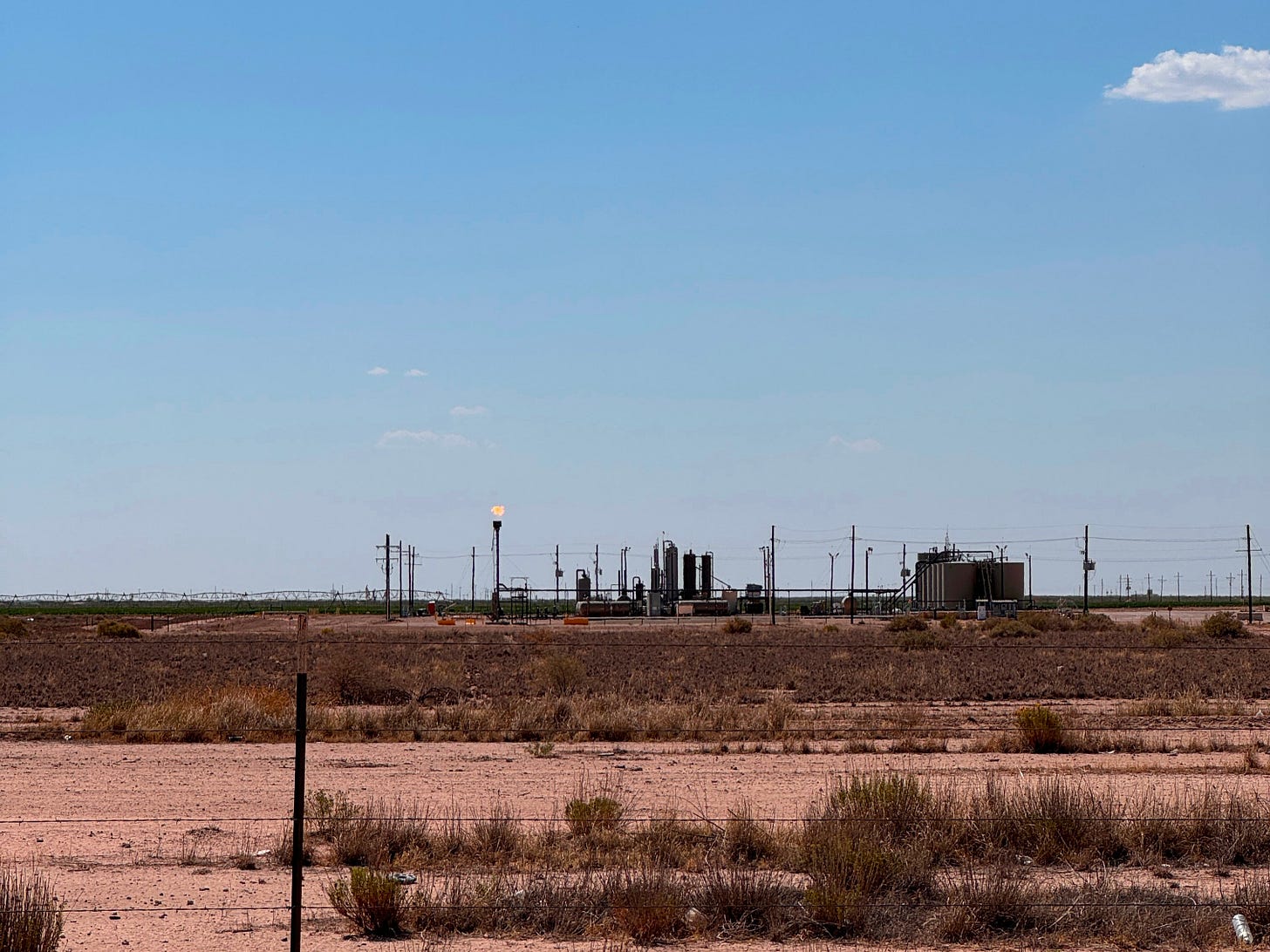Climate Comms in the Altered States
Reckoning with a radically and rapidly changing political landscape
The world feels fundamentally different from just a few months ago. It’s hard to know what to say these days.
Among a barrage of radical actions across the government since the inauguration, the administration has repealed a slew of regulations for protection of the environment and public health, and it has canceled funding for many climate initiatives.
Climate and environmental concerns can seem low priority in the face of all the other political, social, and economic upheaval underway. Yet they remain existential threats we cannot afford to set aside.
In this edition of Tell the Future, we’ve each taken a moment to condense our thoughts and feelings on how the climate landscape has shifted and what it means for business and communications.
Climate Change Is Happening Whether The Government Says So or Not
KB: I’m writing from far West Texas, where it has barely rained in the last two years, and where pumpjacks spread across hundreds of miles of horizon to suck oil from the ground. I just moved here from New York, where it has become so rainy that the ground is too sodden to bury my grandmother, and where luxury condos are still being built 5 feet above sea level.
The impacts of climate change are now a daily fact. Failing to account for the environment in business decisions will impact your bottom line, not to mention the future we are collectively building for customers. It doesn’t matter what administration is in power, our planet is changing, rapidly, and perhaps permanently. The narrow window that we’ve estimated for ourselves is closing.
DK: I learned back in elementary school (in Houston, the oil & gas capital of the country) about the greenhouse effect. At the time, it was just science, not politics. Since then, I’ve lived through a variety of extreme weather events from floods, to freezes, to fires and smoke clouds so dense they exceeded the charts established to measure them.
A 2021 meta analysis of research on climate change showed more than 99% consensus that human activity is causing climate change. Yet EPA “Administrator” Lee Zeldin literally called climate change a religion in an official EPA press release celebrating his deregulation actions. The press release claims these actions will bring down costs of living, which doesn’t really pencil out when extreme weather events keep destroying
Fortunately, while the current regime ordered many federal agencies to remove all references to climate change, NASA still has info up, such as this stark chart showing just how far out of norms we are with atmospheric CO2.
Navigating the Shifting Political Winds
DK: When I first started exploring the climate tech scene, I felt excited and hopeful. I’ve met an array of brilliant and passionate people — technologists, scientists, entrepreneurs — all working on critical, discrete problems aimed at shifting our economy away from fossil fuels. That work remains as vital as ever.
When the Infrastructure bill and Inflation Reduction Acts were passed in the Biden administration, despite the many problems and insufficiency of both, it seemed like there was finally significant momentum building for a clean energy transition.
Leading up Trump’s second term, I was hopeful some of that momentum would be maintained, especially since it was boosting domestic manufacturing and jobs. With the repeal of not just major provisions of the IRA but longstanding environmental protections, those hopes have been erased.
So where do we find hope now? I’ve seen people arguing that, given the continually declining cost of clean energy, the administration can’t stop the energy transition — it can only slow it down. That may be true. We’re so far behind in averting truly disastrous climate change that it’s pretty cold comfort, but I’ll still take it.
Dealing With Public Data Losses
KB: When I started writing this month's newsletter, I wanted to know the 2024 rainfall in my county to fact-check the anecdotal claim about it not raining in two years. On average, this area should see 7-10 inches. I wanted to give credence to my lived experience, and add in a concrete number.
One problem: past rainfall data is dependent on good data collection. If you live in an area that is rural, underfunded or remote, it can be nearly impossible to find. Add in the erasure of public datasets critical for everything from public health to agriculture to climate action, and fact-checking can become a nightmare.
Farmers, land planners and geologists rely on this information for business decisions. Government safeguarding of this data meant that we as a nation had a central place and standard of collection across thousands of counties.
In the last two months, we have seen the systematic purge of climate related data across government agencies at a terrifying speed.
The consequences of this are huge — without reliable, trustworthy public data , it is far easier to dismiss claims of change over time. It is also harder for communities to demand funding for resilience and adaptation or advocate for future needs.
Privatizing the data doesn’t fully solve the issue. Despite the Herculean effort to save climate data, relatively benign weather data has been weaponized by this regime, limited to volunteer archives or scholarly reports, and otherwise made less accessible to curious kids and the public. It makes our collective environment feel more foreign, and our access to it depends on the kindness of strangers. And when that data is gone — it’s like flying blind.
It’s been easy to take for granted the level of information we have access to in our daily lives. It’s also been easy to overlook our blindspots. When it’s quick to find out if it will rain in the next ten days, it’s easy to forget that weather apps don’t publish past weather reports or overall trends.
Impact on Climate Communications
DK: For businesses and organizations wanting to address climate change, the stakes are higher by the day, but the game has utterly changed, especially where communications strategy is concerned.
The headwinds have picked up dramatically. Not only have incentives been removed to drive climate action, but funding has been eliminated across a wide range of programs, staff cut, and the official stance toward climate action ranges from dismissive to hostile.
So how do we work with this? Core principles remain the same — communicating clearly, articulating value, knowing your audience. Match the message to the moment. This is in line with what we’ve been saying since we started this newsletter anyway, so nothing entirely new here, just a stronger imperative.
I came across a post sharing thoughts from the Villars Summit — a recent global meeting of over 300 climate organizations. A key takeaway: keep the work going, but change the narrative. For example, instead of nature and climate, focus on peace and security. The need for coalition-building and strategic collective action is greater than ever — it’s encouraging to see events like this (just in its third year) emerging.
Finding Opportunity in Adversity
KB: In the absence of government authority, people will turn elsewhere for answers. And there are a lot of answers needed. Customers can see how their landscape is changing. Businesses have the opportunity to become a powerhouse of information and hope.
Climate businesses in particular need to remember to start from zero with their communication strategy — don’t mistake the mistake of assuming people know even a fraction of what you know about your area of expertise. The general public has little understanding of how the physical world works and how it impacts their day.
Science education for most people stops in high school, and let’s face it, basic facts like the water cycle and how things grow are learned and forgotten even earlier than that. I recently explained the water table to an accomplished journalist, who sheepishly admitted they hadn’t thought much about it since elementary school.
Storytelling that makes the physical world relevant is needed now more than ever.
Climate in Conversations
KB: I’m always fascinated to see how climate solutions filter into day to day conversations. It’s a way to gauge what people care about when off-script, and messaging opportunities. I’ve long noticed that the heat and the natural disasters are frequent talking points, regardless of political affiliation. People are tired of bad news.
Off-grid living is relatively common where I live, and becoming more widespread and accepted. Government services can be so difficult and expensive to access — on top of already scarce housing — that solar panels and generators are nearly ubiquitous. I’ts an odd sense of dissonance when you’re living in Exxon Mobil’s backyard.
I regularly get questions in my personal life about why hybrids aren’t receiving more attention and incentives. High gas mileage is an easy selling point for everyone, and I don’t have a good answer when EV’s are so expensive and charging infrastructure is so scarce.
What does not get mentioned is also interesting: my county is politically mixed, so the Trump administration is often referenced obliquely as people try to ascertain where you stand on an issue.
We usually think of business communications in big ways: ad campaigns, thought leadership, messaging strategy. It’s important to remember that speaking up in one-to-one conversations is also a powerful way to change people's minds.
Finding Balance in the Chaos
DK: This has been a very difficult post to write. Every time I approached it, I found myself going down internet rabbit holes, weighing various perspectives, opinions, and facts, trying to make sense of where we’re at and where we’re likely headed. A lot of what I’m seeing can be frightening and upsetting.
What seems clear is we are in a pivotal moment for our world. That said, I believe it’s essential to counterbalance “staying informed” with enjoying life. For now, my personal reality remains relatively comfortable with basic services, food, housing, and community. I do not take these things for granted, and I make a point of acknowledging and appreciating them in my thoughts and reflections.
Science has shown that our thoughts and where we place our attention shape our experience. So it’s just as important to pay attention to what is going well, and to look for signs of hope, as it is to seek understanding of current events.
And I do see those signs: people are waking up, speaking out, and organizing to advocate for and build a better world.
Keep working toward the future you want to live in, be strategic with how you talk about it, and keep hope alive.








